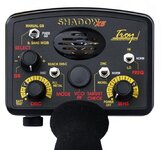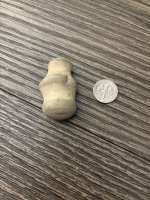Charlie P. (NY)
Gold Member
- Feb 3, 2006
- 13,004
- 17,108
- Detector(s) used
- Minelab Musketeer Advantage Pro w/8" & 10" DD coils/Fisher F75se(Upgraded to LTD2) w/11" DD, 6.5" concentric & 9.5" NEL Sharpshooter DD coils/Sunray FX-1 Probe & F-Point/Black Widows/Rattler headphone
- Primary Interest:
- Metal Detecting
I don't put much stock in air tests. I hunt coins in the dirt, not in the air like skeet. How do you "ground balance" the detector before hand for the air test? Soil and the minerals and moisture in it make it a much better conductor than air and so the relative difference between the coin and its surroundings are less easy to detect.
Bury that dime 9" in your front yard, and then another with a pulltab 1" beside it at 4" down and a third with a nail 1" beside it and 4" down and test again. That's when the higher priced units begin to show their stuff. Can they still see the coin through junk and the null of an iron mask circuit?
If you get a repeatable hit on a quarter 12" down in your test garden you'll probably do all right in the wild. But if you didn't know that quarter was there would you dig on the signal it returns? There is a big difference between "It hits a 12" deep quarter!" and "I get a solid, repeatable signal with a 12" deep quarter and the display value stays constant or only jumps one unit from all directions."
I have 13 "plantings" in my test garden:
'79 Lincoln cent at 8"
'70 Lincoln cent edge-up at 8"
0.715" lead musket ball at 12"
1963D Quarter at 12"
'83 Quarter edge-up at 12"
'06 cent flat at 1/2"
Pull tab at 2" over '81 cent at 6" & offset 1"
Nail at 2" over '78 cent at 6" & offset 1"
'91 Nickel at 6"
'88 dime at 6"
Shotshell base at 5"
Three different style pulltabs side-by-side at 5"
Aluminum screw cap at 4"
Each of these is marked with a plastic golf "T" in a yellow/red/white repeating sequence so I know what I'm over by my map (I keep copy inside the garage and one at my desk so I can grab a detector and test it & myself regularly).
The trash at the tail end is handy as it will tell you how any notch setting is effecting the other targets.
I also keep a find log of what the TID read-out was & indicated depth and then what I dug and actual depth.
Bury that dime 9" in your front yard, and then another with a pulltab 1" beside it at 4" down and a third with a nail 1" beside it and 4" down and test again. That's when the higher priced units begin to show their stuff. Can they still see the coin through junk and the null of an iron mask circuit?
If you get a repeatable hit on a quarter 12" down in your test garden you'll probably do all right in the wild. But if you didn't know that quarter was there would you dig on the signal it returns? There is a big difference between "It hits a 12" deep quarter!" and "I get a solid, repeatable signal with a 12" deep quarter and the display value stays constant or only jumps one unit from all directions."
I have 13 "plantings" in my test garden:
'79 Lincoln cent at 8"
'70 Lincoln cent edge-up at 8"
0.715" lead musket ball at 12"
1963D Quarter at 12"
'83 Quarter edge-up at 12"
'06 cent flat at 1/2"
Pull tab at 2" over '81 cent at 6" & offset 1"
Nail at 2" over '78 cent at 6" & offset 1"
'91 Nickel at 6"
'88 dime at 6"
Shotshell base at 5"
Three different style pulltabs side-by-side at 5"
Aluminum screw cap at 4"
Each of these is marked with a plastic golf "T" in a yellow/red/white repeating sequence so I know what I'm over by my map (I keep copy inside the garage and one at my desk so I can grab a detector and test it & myself regularly).
The trash at the tail end is handy as it will tell you how any notch setting is effecting the other targets.
I also keep a find log of what the TID read-out was & indicated depth and then what I dug and actual depth.








